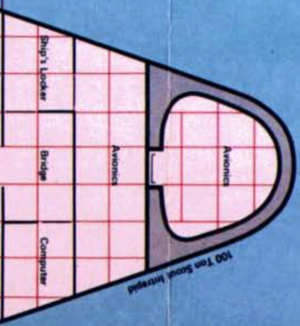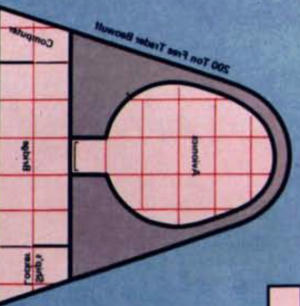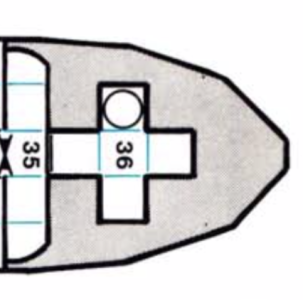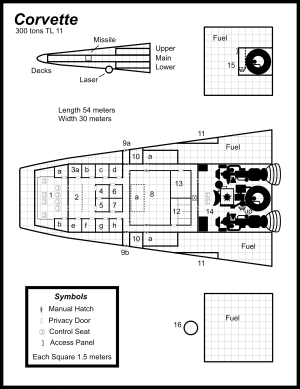- Have you noticed a rough correlation between ship size and number of seats on a Bridge?
Not, particularly, no.
The one constant is that 2 seats is the minimum. Even small craft bridges have 2 acceleration couches in them.
- How many SEATS feel right to you?
For me, it's kind of a function of crew size. The bigger the crew, the more seats there ought to be on the bridge.
Pilot (helmsman) and Navigator are kind of obvious bridge officer workstations, so that's 2 right there (although, not all craft are required to have a navigator on staff).
My assumption is that if a big craft is armed, there should be a workstation on the bridge dedicated to fire control for the command of gunnery crew(s). I'm personally of the opinion that the "manning" of turrets
doesn't mean you put a gunner
IN the turret (like a B-17 ball gunner), but rather that gunnery crews are working from a CIC type remote weapons arrangement. The 1 gunnery position per turret (LBB2 crew rules) is mainly for the purposes of maintenance and upkeep (and reloading for missiles and sandcasters), rather than a matter of physically shoving bodies inside of every turret. The net result is that if you've got 1 gunner on payroll, there ought to be 1 gunnery fire control workstation on the bridge, so when the crew needs to "fight" the craft in combat, the gunnery crewman is working on the bridge with the pilot (and navigator, if any) for improved situational awareness and quicker response to target designation and firing commands. If you've got more than 1 gunner on payroll, there's going to be a fire control center somewhere away from the bridge that has all the "extra" gunners, while the chief gunner has their workstation on the bridge.
For the engineering department, it's a broadly similar notion. There ought to be a chief engineer workstation on the bridge if there are 2+ engineers on payroll, even if the chief engineer spends most of their time away from the bridge, since during combat they may need to be "on the bridge" for situational awareness reasons to relay commands while the crew "fights" the craft against an adversary. If you have only 1 engineer on payroll, then a bridge workstation becomes a luxury.
Craft that have a variety of sub-craft that can be launched may need a flight ops director workstation on the bridge. For quantities of 1-3 embarked sub-craft (think ship's boat, pinnace, modular cutter, etc.), the navigator can "manage" the flight ops role of tracking and directing nearby traffic for rendezvous and course plotting purposes. For 1+ squadrons a dedicated flight ops director workstation should be present on the bridge.
Craft that have a dedicated mission role as a communications relay node (such as Express Tenders) ought to have a bridge workstation for a communications/computer officer.
Craft that have a large cargo hold/hangar bay (ordinary launch facilities) which has "load marshaling" type infrastructure associated with it (robotic arms, grav sleds, etc.) to assist with loading/unloading and docking procedures may have a workstation either on the bridge or in a dedicated location elsewhere aboard. If a craft has a service crew department of crew who are responsible for loadmaster/supercargo duties (which actually winds up being one of the subset of duties included in the Steward skill, in addition to passenger services) then a workstation for controlling such cargo load marshaling infrastructure systems ought to be found SOMEWHERE. Depending on the type of craft (and its deckplan layout), it may make sense to just put a remote teleoperator (trideo?) workstation for those duties on the bridge, rather than requiring them to "look through a window" to see what they're doing.
Medical basically NEVER gets a dedicated bridge workstation ... except maybe some kind of life support monitoring type of deal on much larger craft.
- In your mind, how many people are on the bridge of an ACS of 100 dT? 200 dT? 400 dt? 600 dT? 800 dt? 1000 dt? [I think those are the traditional sizes.]
- 100 = 1-2
- 200 = 1-3
- 400 = 3-4
- 600 = 3-5
- 800 = 4-5
- 1000 = 4-6
Not all of those workstations are necessarily manned 24/7, but if there's a call to general quarters/red alert for any kind of "all hands, battlestations" type of situation, that's how many people I would assume ought to be on the bridge for those various tonnages (because of assumptions of crew sizes, rather than because of a function of straight tonnage).




